In a world where every second counts, staying organized and maximizing efficiency is paramount. That’s where time tracking tools come into play, revolutionizing the way we manage our daily lives.
A few efficient time tools are Onethread, Time Doctor, Clockify, Toggle, Desk Time, etc. These ingenious tools are designed to empower you and make the most of our precious time.
With time tracking tools by our side, we can effortlessly navigate through the demanding demands of modern life, ensuring that every moment is harnessed to its fullest potential.
What are Time Tracking Tools?
Time tracking tools are software applications designed to help individuals and businesses monitor and manage the time spent on various tasks and projects.
They enable users to track the amount of time they dedicate to specific activities, providing valuable insights into productivity, resource allocation, and project progress.
Time tracking tools typically offer features such as timers, timesheets, and reporting functionalities.
Users can start and stop timers to record the duration of a particular task or project, while timesheets allow them to manually input time entries for activities that may not be easily tracked in real-time.
The recorded data is then presented in easy-to-understand reports and visualizations, showing the distribution of time across different tasks or projects.
These tools offer numerous benefits, including enhanced productivity, better project management, and improved billing accuracy for businesses that charge clients based on time worked.
Additionally, time tracking tools can help individuals identify time-wasting activities and focus on more essential tasks, leading to increased efficiency and time management.
In recent years, time tracking tools have evolved to incorporate advanced features like integrations with project management software, automated time tracking based on activity levels, and mobile applications for on-the-go tracking.
While some individuals may have privacy concerns regarding constant monitoring, many find these tools instrumental in optimizing their time and achieving greater work-life balance.
Why Time Tracking Tools are Important for Your Business?
Time-tracking tools are vital in enhancing productivity, project management, resource allocation, client billing, employee accountability, and decision-making processes within a business. They empower businesses to make data-driven choices, achieve greater efficiency, and drive success.
Productivity Monitoring and Optimization
Time-tracking tools provide valuable insights into how employees spend their work hours. By tracking time spent on various tasks and projects, businesses can identify bottlenecks, time-wasting activities, and areas where productivity can be improved.
This information allows managers to make data-driven decisions to optimize workflows, streamline processes, and allocate resources more efficiently.
Project Management and Planning
Efficient project management is crucial for the success of any business. Time tracking tools help set realistic project timelines and deadlines by analyzing historical data and estimating how much time similar projects may take. With accurate time tracking, project managers can better allocate tasks, set achievable milestones, and ensure projects stay on track.
Resource Allocation and Workload Distribution
Time tracking tools allow businesses to distribute workloads evenly among employees. By monitoring individual work hours and task completion times, managers can identify if certain team members are overloaded while others have capacity. This helps in reallocating tasks and ensuring a balanced workload among employees.
Client Billing and Invoicing
Accurate time tracking is essential for businesses that charge clients based on billable hours. Time tracking tools provide a transparent and accurate record of the time spent on client projects, making the billing process smoother and reducing the risk of invoice disputes.
Employee Accountability and Performance Evaluation
Time tracking promotes accountability among employees. When employees know their work hours are monitored, they are more likely to stay focused and productive.
Additionally, time-tracking data can be used as a performance evaluation metric, providing a fair and objective basis for assessing employee contributions and setting performance goals.
Data-Driven Decision Making
Time-tracking tools generate valuable data and analytics that can be used for data-driven decision-making. Businesses can analyze trends, identify patterns, and understand how different factors impact productivity. This information helps make informed decisions to improve operations and achieve better results.
Remote Work and Flexibility
Time-tracking tools have become even more important with the rise of remote work and flexible work arrangements. They enable businesses to monitor remote employees’ activities, ensure they are working productively, and maintain transparent communication regardless of physical location.
Compliance and Legal Requirements
Certain industries and labor laws have strict requirements regarding employee work hours and breaks. Time tracking tools help businesses comply with these regulations by accurately recording work hours, overtime, and breaks, reducing the risk of legal issues and penalties.
Key Features to Consider in Time Tracking Tools
By considering the below mentioned key features in time tracking tools, you can select a solution that aligns with your business goals, enhances productivity, and simplifies time management for your team.
Time Tracking Methods
Look for time tracking tools that offer multiple methods for tracking time, such as manual entry, timers, and automatic tracking based on activity levels. Manual entry allows users to input time on tasks after completion, while timers enable real-time tracking.
Automatic tracking can benefit those who prefer a hands-off approach, as it captures time spent on activities without manual intervention.
Reporting and Analytics
A robust time-tracking tool should provide comprehensive reporting and analytics features. The tool should offer various pre-built reports and customizable options, allowing users to view time data in different formats and time frames. Analytical insights help businesses identify patterns, trends, and areas for improvement.
Integration with Other Tools
Consider time-tracking tools that integrate with other essential software your business uses, such as project management, invoicing, or payroll systems. Seamless integration streamlines processes and reduces the need for duplicate data entry.
User-Friendly Interface
An intuitive and user-friendly interface is essential for easy adoption and efficient usage of the time tracking tool. Look for a tool that is straightforward to navigate and requires minimal training for employees to start using effectively.
Mobile Accessibility
In today’s mobile-centric work environment, having a time-tracking tool with mobile accessibility is beneficial. A mobile app allows employees to track their time on the go, whether remotely or in the field.
Task and Project Management
Some time-tracking tools have built-in task and project management capabilities. These features enable users to associate tracked time with specific projects or tasks, providing a more detailed view of time allocation and progress.
Billing and Invoicing
If your business bills clients based on time worked, consider a time-tracking tool that integrates billing and invoicing features. This simplifies billing by automatically generating accurate invoices based on tracked time.
Permissions and Access Control
Security and data privacy are crucial when using time-tracking tools. Ensure the tool offers robust permission settings, allowing you to control who can view, edit, or delete time entries and reports.
Offline Mode
A time-tracking tool with an offline mode is valuable for businesses with intermittent internet access or remote work scenarios. This feature enables users to continue tracking time even when not connected to the internet, and the data syncs once the connection is restored.
Customization Options
Every business has unique needs, so consider a time-tracking tool that offers customization options. This includes adding custom fields, tailoring reports to specific requirements, and adapting the tool to suit your business processes.
Top 13 Time Tracking Tools
Whether it’s a sleek digital calendar that keeps us on schedule, a sophisticated task management app is crucial. It helps us prioritize our to-do lists, or a simple yet elegant stopwatch that keeps us focused during workouts.
1. Onethread
Onethread is a time management tool designed to streamline communication and collaboration. It helps users manage their time effectively by providing real-time messaging, threaded conversations, and advanced search capabilities.
Centralizing communication reduces time spent searching for information and enhances productivity through efficient collaboration and task management.
Overview & Key features
- Tracking time and management capabilities
- Task organization and prioritization tools
- Integration with calendars and scheduling applications
- Reporting and analytics for tracking time usage and productivity
Pros
- Efficient time management and productivity enhancement
- Seamless integration with existing time-related tools and workflows
- Simplified task organization and prioritization
Cons
- Potential learning curve or adjustment period when adopting a new time tool
Price Plan & Options
Image Goes Here: Drive Link
- Starter: Free Forever (Limited Features)
- Growth: 200 BDT/User/Month
- Scale: 400 BDT/User/Month
- Enterprise: Contact OneThread team for Pricing
2. Clockify
Clockify is a versatile time tracking software that helps individuals and teams efficiently manage their time and productivity. With its user-friendly interface and extensive features, Clockify offers several benefits and advantages.
Clockify’s website has over 3 million people and 60,000 companies use Clockify to track their time and improve productivity. With its wide user base and positive customer reviews, Clockify has established itself as a popular choice in the time tracking software market.
Overview & Key features
- Clockify allows users to track their time spent on tasks, projects, and clients effortlessly.
- Users can create and manage projects, assign tasks, set deadlines, and track progress within the platform.
- Clockify offers various reporting features, including detailed time reports, summary reports, and visual charts, providing valuable insights into productivity and performance.
- Clockify integrates with popular project management and collaboration tools, enhancing workflow efficiency.
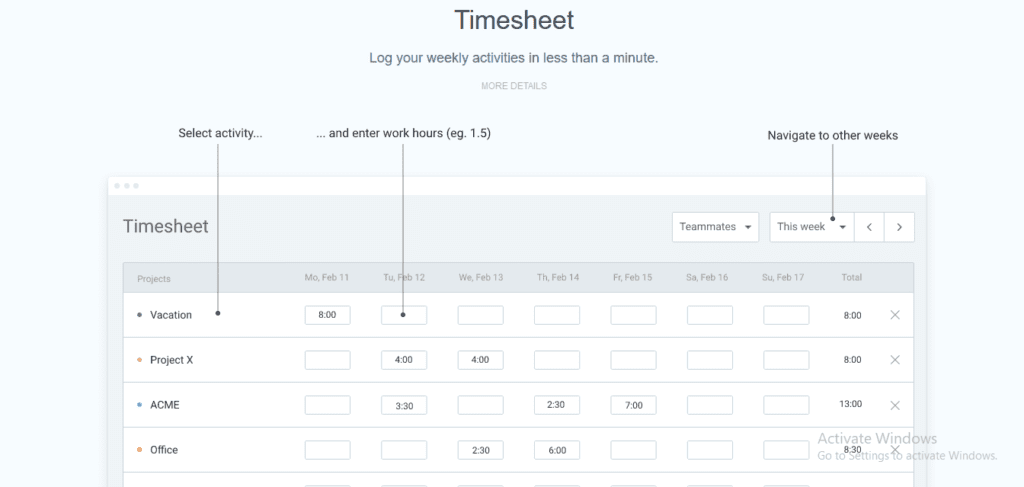
Pros
- Clockify provides a simple and intuitive interface, making it easy for users to track their time and manage tasks without any hassle.
- Users have the freedom to customize Clockify according to their specific needs, including creating custom fields, tags, and reports tailored to their workflow.
- Clockify enables seamless collaboration among team members by allowing them to track their time, assign tasks, and monitor progress in real-time, fostering effective teamwork and boosting productivity.
Cons
- While Clockify integrates with popular project management tools like Trello and Asana, the range of integrations is somewhat limited compared to other time tracking software.
- Clockify’s reporting capabilities, while functional, may not provide in-depth analytics or advanced reporting features required by some businesses.
Price Plans & Options
- Basic: $3.99
- Standard: $3.99
- PRO: $7.99
- Enterprise: $11.99
3. Time Doctor
Time Doctor is a powerful time tracking and productivity management tool designed to help individuals and teams optimize their time and improve overall efficiency. It offers several features and benefits to enhance productivity and time management.
According to a survey conducted by Time Doctor, their users reported an average increase in productivity by 22%. With over 80,000 companies relying on Time Doctor to improve time management and boost productivity, it has established itself as a trusted solution in the market.
Overview & Key features
- Tracks time spent on tasks and projects with precision.
- Provides detailed insights into productivity levels and identifies potential bottlenecks.
- Captures screenshots and monitors app and website usage for improved accountability.
- Enables efficient project planning, task management, and collaboration.
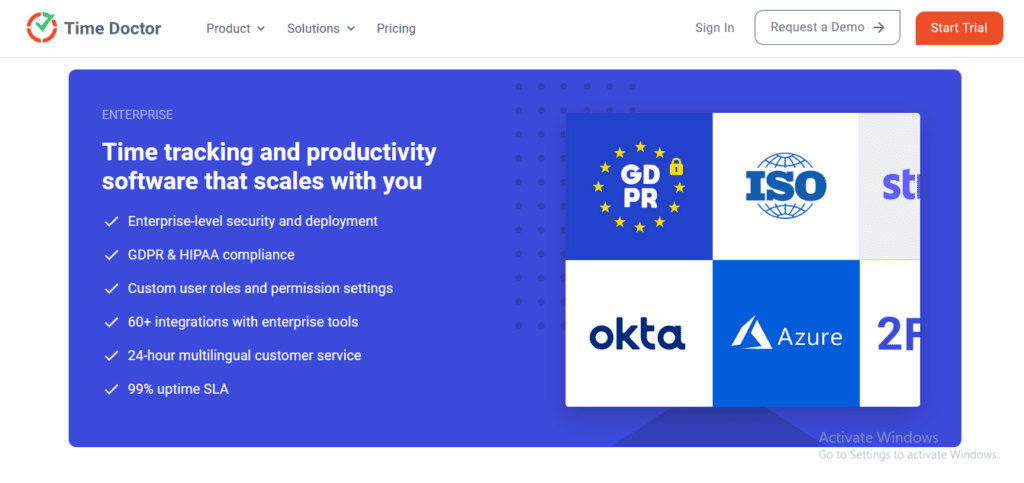
Pros
- Time Doctor accurately tracks time spent on tasks and projects, providing valuable insights into productivity levels and identifying areas for improvement.
- The software allows employers to monitor employee activities, ensuring accountability and preventing time wastage.
- Time Doctor seamlessly integrates with popular project management and communication tools, enabling efficient workflow management and streamlined collaboration.
Cons
- Time Doctor requires an internet connection for full functionality, limiting its usage in offline environments.
- As Time Doctor includes employee monitoring features, there may be concerns regarding privacy invasion. It is essential to establish clear policies and communicate expectations to maintain trust within the team.
Price Plans & Options
- Basic: $5.9/user/month
- Standard: $8.4/user/month
- Premium: $16.7/user/month
4. RescueTime
RescueTime is a time management tool that helps users track and analyze their digital activities to improve productivity.
Overview & Key features
- Automatic time tracking of computer and mobile device usage.
- Detailed reports and analytics on time spent on different applications and websites.
- Goal setting and productivity alerts.
- FocusTime feature to block distracting websites during specified periods.
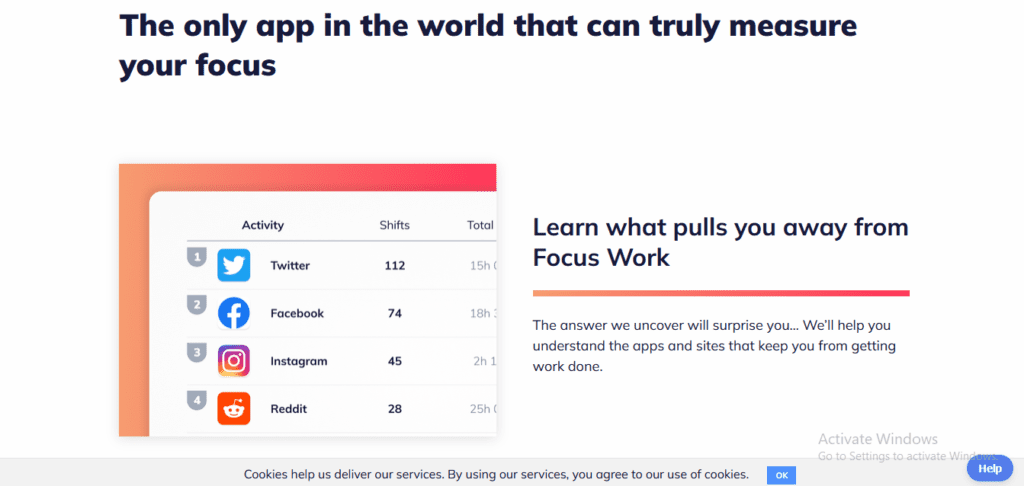
Pros
- Provides valuable insights into time usage patterns.
- Helps identify and eliminate time-wasting activities.
- Offers productivity tools and goal-setting features to enhance focus and efficiency.
Cons
- Requires active user engagement to make the most of the tool’s features.
Price Plans & Options
RescueTime offers both a free plan and a premium plan. The premium plan, “RescueTime Premium,” is a monthly or annual subscription.
- 2 weeks free trial
- $6.50/month
5. Ntask
Ntask is a comprehensive task management software designed to streamline workflow and increase productivity for individuals and teams. It offers a range of key features that help users stay organized and efficiently manage their tasks.
With Ntask, users can optimize their task management process, improve collaboration, track time effectively, and integrate with other productivity tools. It is a versatile solution that empowers individuals and teams to achieve better results and maximize their productivity.
Overview & Key features
- Task management with prioritization and assignment
- Collaboration tools for seamless teamwork
- Time tracking and reporting for improved productivity analysis
- Integration with popular productivity tools for enhanced efficiency
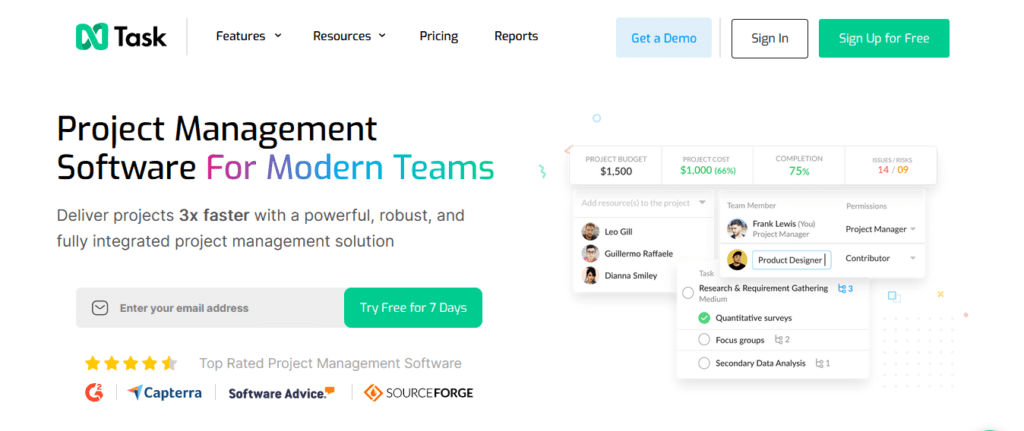
Pros
- Efficient task management with clear prioritization and assignment
- Seamless collaboration among team members, promoting effective teamwork
- Detailed time tracking and reporting for enhanced productivity analysis
Cons
- Some users may find the interface overwhelming due to the abundance of features
Price Plans & Options
Ntask offers flexible pricing plans to accommodate various needs. The plans include a Free tier for basic functionality, a Premium tier starting at $3 per user per month with advanced features, Most popular plan is Business plan which cost $8/month and an Enterprise tier for large-scale organizations with customized pricing.
6. Tick
Tick is a time-tracking software designed to assist businesses in managing and monitoring their projects and tasks efficiently.
Overview & Key features
- Project and task tracking with time entries.
- Team collaboration and resource management.
- Detailed reporting and analytics on project progress.
- Integration with popular project management tools.
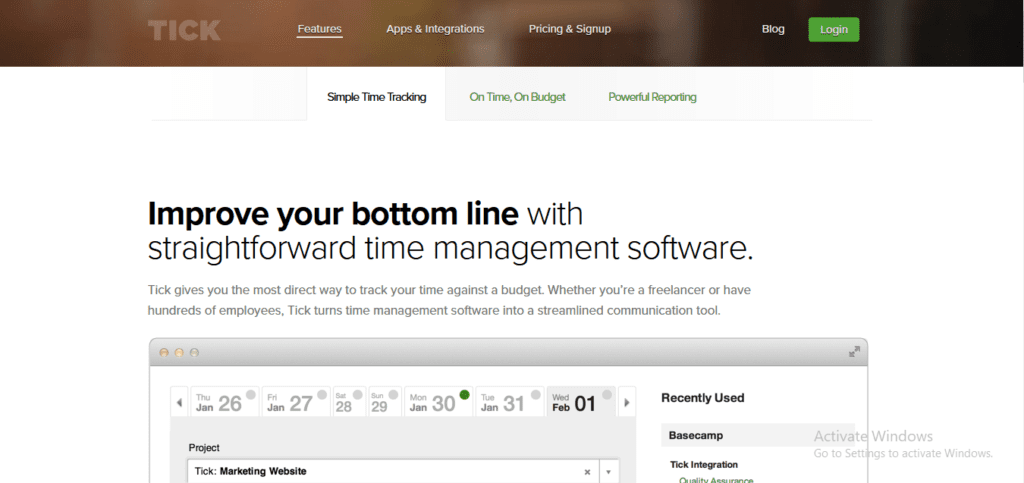
Pros
- Streamlines project management by tracking time spent on tasks.
- Facilitates better resource allocation and project budgeting.
- Enhances team collaboration and communication.
Cons
- It may have a learning curve for new users to navigate the software effectively.
Price Plans & Options
Tick offers various pricing plans based on the number of projects and users. The plans range from small teams to large enterprises.
- 1 Free Project
- 10 Projects: $19/month
- 30 Projects: $49/month
- 60 Projects: $79/month
- Unlimited Projects: $149/month
7. DeskTime
DeskTime is a comprehensive time tracking and productivity software that helps individuals and teams optimize their work efficiency. With a user-friendly interface and powerful features, it offers several benefits for businesses and professionals.
DeskTime has helped businesses increase productivity by an average of 30% and reduce time wasted on unproductive activities by 40%. With its robust features and intuitive interface, DeskTime empowers individuals and teams to optimize their work habits and achieve better results.
Overview & Key features
- Automatic time tracking
- Project and task management
- Customizable reports and analytics
- Absence and leave management
Pros
- Accurate tracking of time spent on tasks
- Employee monitoring capabilities for better accountability
- Detailed productivity analysis to identify areas for improvement
Cons
- Potential privacy concerns related to employee monitoring
Price Plans & Options
DeskTime offers pricing plans based on the number of users and additional features required. For example, the Basic plan starts at $7 per user per month and includes core time tracking features, while the Pro plan at $9 per user per month offers advanced analytics and productivity features.
8. Everhour
Everhour is a time-tracking and resource management tool that helps teams and businesses track and manage their time effectively.
Overview & Key features
- Accurate time tracking and timesheet management.
- Project and task tracking with estimated vs. actual time comparisons.
- Real-time collaboration and team scheduling.
- Integration with popular project management tools.
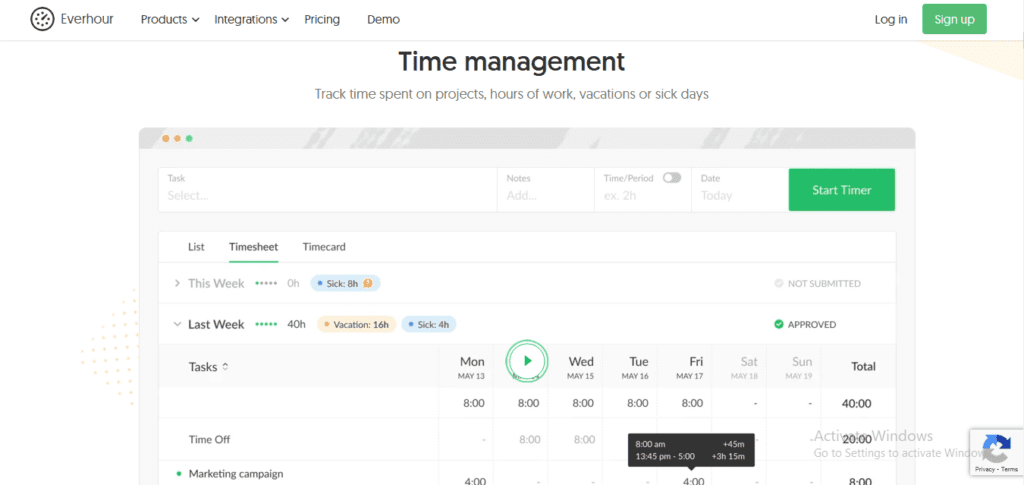
Pros
- Streamlines time tracking and improves project cost estimation.
- Facilitates efficient resource allocation and project planning.
- Enhances team collaboration and productivity.
Cons
- It may require integration with other project management tools for comprehensive project management capabilities.
Price Plans & Options
Everhour offers various pricing plans, including free and paid options. Paid plans are available on a per-user, per-month basis.
- $0 for up to 5 users
- $5/user/month; up to 2 users
- $8.50/user/month; up to 5 users
9. Timecamp
Timecamp is a comprehensive time tracking and productivity software that helps individuals and teams manage their time, track tasks, and improve overall efficiency.
Overview & Key features
- Automatic time tracking with manual editing options
- Project and task management tools for efficient workflow organization
- Attendance tracking and timesheet management
- Reporting and analytics features for detailed insights and productivity evaluation
Pros
- User-friendly interface with easy navigation
- Seamless integration with popular project management tools
- Robust invoicing capabilities for accurate billing
Cons
- Lack of advanced features in the free version
Price Plans & Options
- Free: $0
- Starter: $2.99
- Basic: $5.99
- PRO: $7.99
10. Toggl
Toggl’s automated time tracker tool is designed to help individuals and teams manage their time more effectively. Toggl is widely regarded for its simplicity, efficiency, and versatility.
Its intuitive interface allows users to track their time effortlessly and gain valuable insights into their work habits. With Toggl, users can boost productivity, improve time management skills, and enhance overall efficiency.
Overview & Key features
- One-click time tracking with customizable timers
- Detailed reports and analytics for accurate time analysis
- Integration with popular productivity tools like Asana, Trello, and Slack
- Idle time detection and reminders to ensure accurate time tracking
Pros
- User-friendly interface makes it easy to use and navigate
- Seamless integration with various platforms and devices
- Robust reporting and analytics features provide valuable data insights
Cons
- Advanced features are limited in the free version
- Lack of project management capabilities compared to dedicated project management tools
Price Plans & Options
Toggl offers a free plan with basic features. The paid plans start at $8 per user per month, offering advanced features such as project management, billable rates, and team reporting. The cost for the Business Plan is $13.35.
11. Harvest
Harvest is a popular time tracking and invoicing software that helps individuals and businesses effectively manage their time, track project progress, and streamline their billing processes. Harvest has been trusted by over 50,000 businesses worldwide.
Overview & Key features
- Time tracking with automatic reminders and timers
- Project management tools for task assignment and progress monitoring
- Robust reporting and analytics for comprehensive insights
- Invoicing features with customizable templates and payment integrations
Pros
- Intuitive and user-friendly interface
- Seamless integration with various third-party tools
- Efficient collaboration features for team projects
Cons
- Limited customization options for invoice templates
Price Plans & Options
Harvest offers 2 pricing plans. The “Harvest” plan costs $0 free forever for 1 user and 2 projects.
The “Harvest PRO” plan costs $10.80/user/month for unlimited users and projects.
12. ProofHub
ProofHub is a comprehensive project management software that streamlines collaboration and boosts productivity. Here’s a concise overview of ProofHub: It is an all-in-one project management solution that simplifies teamwork and ensures efficient project execution.
According to a survey, 87% of ProofHub users reported increased team productivity, and 92% expressed satisfaction with the software’s ease of use.
Overview & Key features
- Task management with deadlines, dependencies, and progress tracking
- Discussion boards for seamless team communication
- File sharing and document collaboration
- Gantt charts for visualizing project timelines
Pros
- Intuitive and user-friendly interface
- Centralized platform for task management, team communication, and file sharing
- Time tracking and reporting features for efficient project monitoring
Cons
- Limited customization options compared to some competitors
Price Plans & Options
Free Plan:
- The Free Plan is designed for individuals and small teams wanting to start with basic project management features.
- It includes task management, file sharing, discussions, and time tracking for a limited number of projects and users.
Essential Plan:
- The Essential Plan is suitable for small teams and includes all the features of the Free Plan, plus more advanced project management capabilities.
- It offers features like Gantt charts, Kanban boards, custom roles, and project templates.
- The cost of the Essential Plan started at around $45 per month when billed annually.
Ultimate Control Plan:
- The Ultimate Control Plan is designed for larger teams and organizations that require more advanced project management and administrative features.
- It includes all features of the Essential Plan, along with additional benefits like custom workflows, advanced reports, and custom branding.
- The cost of the Ultimate Control Plan started at around $89 per month when billed annually.
13. Hubstaff
Hubstaff is a comprehensive time tracking and productivity management software designed for remote teams. Its key features include time tracking, employee monitoring, project management, and online timesheets.
With Hubstaff, teams can efficiently monitor and collaborate on tasks and projects, leading to enhanced productivity and accountability. The software also offers valuable productivity insights and seamless integrations with other tools.
Overview & Key features
- Time tracking: Easily track time spent on tasks and projects.
- Employee monitoring: Monitor employees’ activities for enhanced accountability.
- Project management: Create and assign tasks, set deadlines, and collaborate effectively.
- Online timesheets and invoicing: Simplify billing and generate professional invoices.
Pros
- Hubstaff provides a centralized platform for managing remote teams.
- Gain valuable insights into time usage and productivity levels.
- Seamlessly integrate with popular tools and platforms for enhanced efficiency.
Cons
- Initial setup and learning may require some effort.
Price Plans & Options
Hubstaff offers three pricing tiers:
- Desk Free: Suitable for one user with limited features.
2. Desk Starter: Starts at $5.83 per user per month, with advanced time tracking and activity monitoring features.
3. Desk Pro: Starts at $8.33 per user per month, offering additional features like invoicing and integrations.
4. Enterprise: Get a customized plan contacting Hubstaff customer care.
Comparison Chart: Top Time Tracking Tools at a Glance
Explore the leading time tracking tools with our comprehensive comparison chart for informed decision-making. Boost productivity today!
| Time Tracking Tools | Feature 01 | Feature 02 | Feature 03 | Feature 04 | Feature 05 |
| Onethread | Real-time tracking | Task-based tracking | Integrated communication | Productivity reports | Time allocation insights |
| Clockify | Simple and user-friendly | Time entry and editing | Project and client tracking | Reporting | Billable hours tracking |
| Time Doctor | Automatic time tracking | In-depth activity reports | Website and app usage monitoring | Time use alerts | Payroll and invoicing |
| Rescue Time | Automatic time tracking | Detailed activity stats | Focus mode to minimize distractions | Goal setting | Weekly email summary |
| Ntask | Task-based time tracking | Team collaboration | Timesheets and time approvals | Task and project reports | Customizable task workflows |
| Tick | Timer-based tracking | Budget tracking | Mobile time tracking | Expense tracking | Client invoicing |
| DeskTime | Employee attendance | Efficient project tracking | Absence and leave management | Automatic screenshots | Project cost estimation |
| Evehour | Easy project tracking | Task and expense tracking | Invoice and billing integration | Resource management | Customizable reporting |
| Timecamp | Timesheet approvals | Attendance tracking | Billable and non-billable hours tracking | Project budgeting | Integrations with other tools |
| Toggl | One-click time tracking | Team dashboards | Pomodoro timer for focused work sessions | Project time estimates | Project time estimates |
| Harvest | Project and task tracking | Expense tracking | Timesheet approvals and invoicing | Budget tracking | Integration with third-party apps |
| ProofHub | Manual time entries | Time on specific tasks | Activity logs and project wise time reports | Timer-based tracking | Billable and non-billable hours tracking |
| Hubstaff | GPS and location tracking | Online timesheets | Employee monitoring and activity levels | Payroll and invoicing | Automated payroll reports |
Getting the Most Out of Time Tracking Tools
Getting the most out of time-tracking tools is essential for maximizing productivity and efficiency in personal and professional settings. Here are some valuable tips to make the best use of these tools:
- Set Clear Objectives: Clearly define what you want to achieve with time tracking. Identify specific goals, such as improving time management, increasing billable hours, or identifying areas of improvement.
- Select the Right Tool: Choose a time-tracking tool that aligns with your needs and preferences. Consider features like ease of use, platform compatibility, reporting capabilities, and integrations with other apps.
- Accurate Time Logging: Consistently and accurately log your time entries. Record the time spent on different tasks and projects to get precise insights into your productivity patterns.
- Create Categories and Tags: Organize your tasks and projects with categories and tags. This helps in better categorization and enables you to analyze time usage based on different aspects of your work.
- Regularly Review Reports: Utilize the reports generated by the time tracking tool to gain valuable insights into your time management habits. Identify time-wasting activities, patterns of peak productivity, and areas needing improvement.
- Identify Distractions: Analyze the tracked data to identify common distractions. Address and minimize these distractions to improve focus and efficiency.
- Use Reminders and Alerts: Set up reminders and alerts to prompt you to track time consistently. This ensures that no time entries are missed, providing accurate records of your activities.
- Integrate with Other Tools: Many time-tracking tools offer project management, communication, and calendar app integrations. Explore these integrations to streamline your workflow and reduce manual data entry.
- Involve the Team: If you work in a team, encourage everyone to use the same time tracking tool. This fosters transparency, collaboration, and accountability for time management.
- Analyze and Adjust: Regularly analyze your time tracking data and adjust as needed. Experiment with strategies to enhance productivity and find what works best for you.
Conclusion
Overall, time tracking is an essential tool for individuals and organizations seeking to maximize their productivity and efficiency.
Time tracking tools enable better time management, promotes accountability and transparency, supports effective project monitoring, and facilitates accurate invoicing and billing.
By harnessing the power of time tracking tools, individuals and teams can optimize their work habits, improve their performance, and achieve their goals more effectively.
FAQ
What is the purpose of time tracking tools?
The purpose of a time tracking tool is to monitor and record the amount of time individuals or teams spend on tasks, projects, or activities. It helps businesses improve productivity, optimize resource allocation, track billable hours, and make data-driven decisions based on time data.
What are the benefits of tracking tools?
The benefits of tracking tools include enhanced productivity through identifying inefficiencies, better project management with accurate time allocation, improved resource allocation and workload distribution, transparent billing and invoicing for clients, data-driven decision-making, and increased accountability among employees.
What is the best way to track your time?
The best way to track your time is to use a time tracking tool that suits your needs and preferences. Choose a method that aligns with your work style, such as manual entry, timers, or automatic tracking. Consistently record your activities to gain valuable insights into productivity and time management.
How do you use a time tracker?
To use a time tracker, first, select a suitable time tracking tool or app. Decide on the tracking method—manual entry, timers, or automatic tracking based on activity levels. Start and stop timers for tasks or projects, manually enter time spent if needed, and review reports to analyze productivity and manage time efficiently.